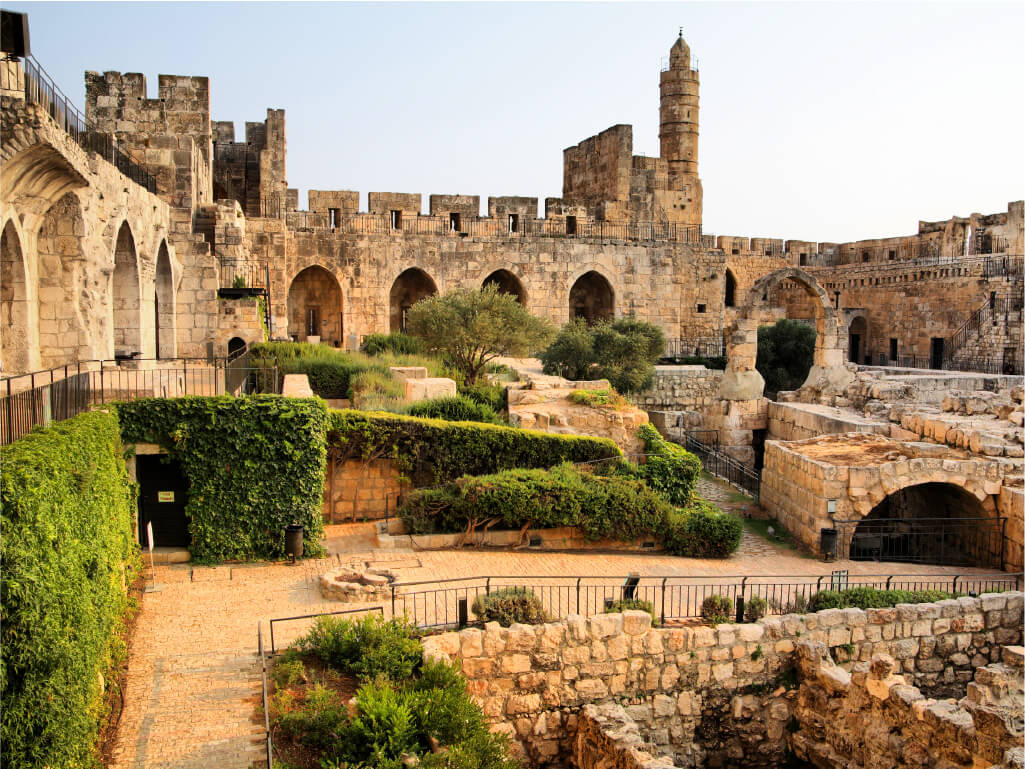
Jerusalem (Yeru-shalayim), usually translated from Hebrew as “the City of Peace,” is the crown jewel of Israel that shines at 2,500 feet above sea level. Jerusalem is a large, modern city today, but the “proper” City of David was much smaller. The ancient City of David sat on the narrow ridge of a hilltop, slightly south of what is today called the “Old City.” For over 150 years The City of David has been revealing some of the most important archeological discoveries of the ancient world. During the days of Abraham, some 4,000 years ago, the first foundations of the city were laid by the Jebusites
One thousand years later, King David left the city of Hebron, conquered the Jebusite city, and establish a unified capital of the tribes of Israel in Jerusalem. Years later, King Solomon, David’s son, built the First Temple north of the city on Mount Moriah, the very site where Abraham offered Isaac to the Lord.
The location for the city that David claimed had two important attributes: fresh water from the Gihon Spring, and the defensive security of being on this steep hillside. The Kidron Valley protected the extremely narrow city on the east, with the west guarded by the Central Valley, and the south by the Hinnom Valley’s merger with the other two.
There are so many sites to see here. A tour of the City of David begins with an observation point of biblical Jerusalem overlooking the Kidron, Central and Hinnom Valleys As you move through the city you will see archaeological excavations and thrilling biblical finds spanning thousands of years of history including both First and Second Temple Jerusalem. Continue underground to the Gihon Spring, the major water source of Jerusalem for over 1,000 years. From here you can choose to trek through knee deep water in King Hezekiah's 2,700-year-old water tunnel or walk through a dry tunnel immersing yourself in the wonders of early engineering. Then continue to the Shiloah Pool, the major water source in biblical times, and reach the Herodian Road, the ancient thoroughfare that led pilgrims north to the Temple.
Today’s visitor can see the ruins of David’s Palace, discovered in 2005. There are two parts: The Stepped Stone Structure (the Millo) and the Large Stone Structure (2 Samuel 5:7-9, 16:22).
A visit is your passport to the past and biblical Jerusalem.
Hezekiah’s Tunnel
To understand Hezekiah’s Tunnel and to truly appreciate this tremendous feat of engineering, some background is needed. Judah had been reduced by Assyria to a vassal state, as was most of the world, but when Sargon King of Assyria died these suppressed kingdoms rebelled…and were crushed by his son Sennacherib’s armies (Micah 1:8-12).
Hezekiah was the king of Judah at this time (726-697 B.C.), and he refused to pay tribute to Sennacherib (2 Kings 18:7), trusting in an alliance with Egypt instead (Isaiah 36:4-7). The natural response to this rebellion was to invade Judah, which prompted Hezekiah to agree to pay the tribute of 300 talents of silver and 30 talents of gold, but he did so by stripping down the Temple (2 Kings 18:14-16).
This concession was too little, too late, though, and Assyria marched on Jerusalem (Isaiah 36:1-2). Withstanding this siege would require ensuring there would be enough water for the city to survive, which meant a tunnel would need to be dug from the spring (2 Chronicles 32:1-4).
In 1880, a boy discovered an inscription on the tunnel wall while bathing. It has since been removed to the Istanbul Museum, but it explained the rare engineering feat of digging through solid bedrock with picks, axes, and a bucket brigade. It described two teams digging simultaneously from opposite directions:
“And when the tunnel was driven through...the hewers wielded the ax, each man toward his fellow...there was heard a man's voice calling to his fellow...the hewers hacked each toward the other, ax against ax, and the water flowed from the spring to the pool, a distance of 1,200 cubits....”
In 1867, Charles Warren conducted the first excavations of the Temple Mount. Warren is credited with the discovery of the water shaft that brought water from the Gihon Spring into Jerusalem in ancient times. In honor of his work, the shaft was named Warren’s Shaft, as he was the first one to actually walk it for centuries.
Hezekiah’s Tunnel is a remarkable experience, though not as difficult today as when Warren first discovered it. Still, at 2 feet wide and 5 feet high for much of the tunnel, it can be a bit of a challenge. On a summer day, the 63-degree, spring-fed water is very refreshing, but not advisable during the winter months without a change of clothes, because you will get wet (the water level rises from your ankles to your knees to your waist). Give yourself about 40-60 minutes to wade through the 1,740-foot tunnel and be sure to bring a flashlight or headlamp
If you don’t want to get wet, then you can take the dry Canaanite Tunnel (to the immediate left of the main tunnel), which was used for crop irrigation. It’s narrow, but completely passable. The source of the water’s flow, the Gihon Spring, is also famous as the spot where Solomon was crowned King of Israel (1 Kings 1:38-40). Standing on the very ground where Solomon was anointed king is something you can experience as part of the underground, dry tunnel walk.
You can also walk down the Herodian street (also underground) that myriads of Jews walked up to the Temple from the Pool of Siloam. This is the same path Jesus would have used 2,000 years ago. These tunnels were the last hiding places during the Roman destruction, and excavations in the tunnels revealed a Roman sword in its leather sheath.
The whole tunnel system exposes an aspect of Jerusalem that leaves you astounded at the engineering skill involved. When you consider what it took to complete the construction above ground, what Ilies beneath only adds to the marvel of the City of David.
Pool of Siloam
In 2004, an old Turkish sewage pipe exploded in Jerusalem and during the subsequent repair, two ancient stone steps were found by the construction crew. Normally this would not make much news in Israel, even though it was near Hezekiah’s Tunnel that carries fresh water from the Gihon Spring, but the coins and pottery found dated it from the Second Temple period. It proved to be vastly important as these steps led the excavators down to where John recorded Jesus had healed a blind man (John 9:1-12).
Located south of the City of David, on the west side of the eastern hill, the recently excavated reservoir is shaped like a trapezoid, with three sets of five steps that run for 225 feet alongside it. This massive pool dates to the siege of King Sennacherib of Assyria and King Hezekiah’s famous water tunnel in the 8th century (2 Chronicles 32).
There are two pools that were identified as the Pool of Siloam. The traditional and older Pool of Siloam, now called the Byzantine Pool, was discovered in the 5th century. It is a narrow rectangle that was fed by the waters from Hezekiah's Tunnel. Around 450 A.D., a church was built next to it by the Byzantine empress Eudocia, which the Persians destroyed in 614 AD. Early Christian pilgrims came here to celebrate Jesus' miracle, but it was the wrong pool.
The much larger 2004 Pool of Siloam is about 70 yards away from the older pool, and the actual one that John records in his Gospel. It had disappeared under centuries of winter rains that sent sediment and debris downhill, on top of the destruction from 70 A.D. Before this burial, the pool was an important part of the Feast of Tabernacles.
Jewish pilgrims brought their harvest crops here in a musical procession, waving a palm branch with myrtle tied to it by a golden thread (lulav) in one hand and a citrus fruit (etrog) in the other, to watch the priest draw water from the pool in a golden pitcher, which was then taken to the Temple with great fanfare and trumpets (Leviticus 23:40-40). The High priest would receive it from him and pour it into a basin, with a second pouring of wine into a separate basin while singing praises to God from Psalm 118 (Isaiah 12:3).
It was at this moment, when there was a silent pause in the ceremony, that Jesus revealed Himself as the Sent One, promising “living water” to “save now” those who had “gained their sight” by believing in Him (John 7:37-38). As they sang Psalm 118:22-27, they prophetically confirmed Him as their Messiah,
The Greek word Siloam is derived from the Hebrew word “shiloach,” which means, “sent” Our English equivalent is “apostle,” which means, “sent one.” Interestingly, the Sent One only does two miracles in Jerusalem. Jesus heals a lame man at the Bethesda Pool (John 5:2-9) and a blind man at the pool of Siloam, both of which have added significance to His Davidic identity from 2 Samuel 2:5-8,
The rest of the pool, extending an additional 120 feet, remains buried, The Greek Orthodox Church who owns the property has not allowed the excavation to continue.
FROM THE SCRIPTURES
And David lived in the stronghold and called it the city of David. And David built the city all around from the Millo inward. And David became greater and greater, for the LORD, the God of hosts, was with him (2 Samuel 5:9 ESV).
Awake, awake, put on your strength, O Zion; put on your beautiful garments, O Jerusalem, the holy city; for there shall no more come into you the uncircumcised and the unclean. Shake yourself from the dust and arise; be seated, O Jerusalem; loose the bonds from your neck, O captive daughter of Zion. (Isaiah 52:1-2 ESV).
This same Hezekiah closed the upper outlet of the waters of Gihon and directed them down to the west side of the city of David. And Hezekiah prospered in all his works (2 Chronicles 32:30 ESV).
As he passed by, he saw a man blind from birth. And his disciples asked him, “Rabbi, who sinned, this man or his parents, that he was born blind?” Jesus answered, “It was not that this man sinned, or his parents, but that the works of God might be displayed in him. We must work the works of him who sent me while it is day; night is coming, when no one can work. As long as I am in the world, I am the light of the world.” Having said these things, he spit on the ground and made mud with the saliva. Then he anointed the man’s eyes with the mud and said to him, “Go, wash in the pool of Siloam” (which means Sent). So he went and washed and came back seeing (John 9:1-7 ESV).




